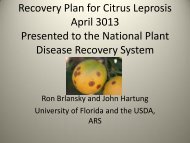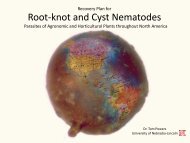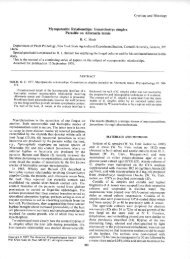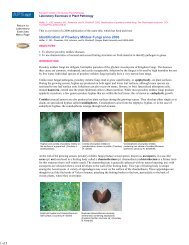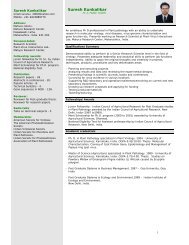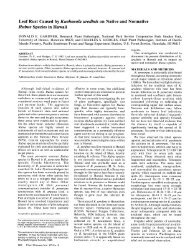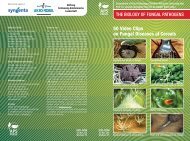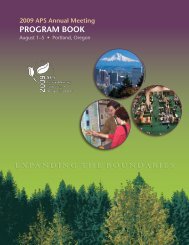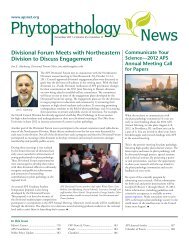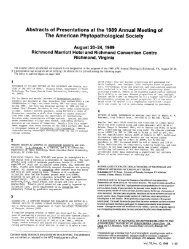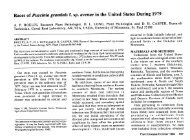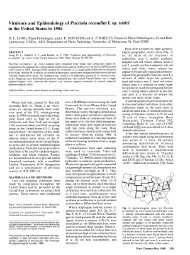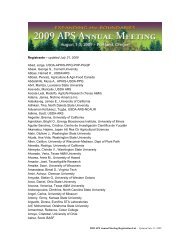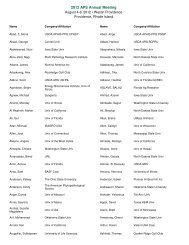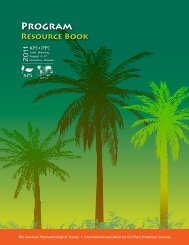See the program book (PDF) - American Phytopathological Society
See the program book (PDF) - American Phytopathological Society
See the program book (PDF) - American Phytopathological Society
Create successful ePaper yourself
Turn your PDF publications into a flip-book with our unique Google optimized e-Paper software.
Monday Afternoon Special Sessions<br />
Listed in alphabetical order by title.<br />
Epidemiology and Food Security: Historically Linked,<br />
Future of Promise<br />
1:00 – 3:00 p.m. * 200 ABC<br />
Section: Epidemiology/Ecology/Environmental Biology<br />
Organizers/Moderators: Serge Savary, International Rice<br />
Research Inst., Metro Manila, Philippines; Pierce A. Paul,<br />
Ohio State Univ, Wooster, OH<br />
Sponsoring Committees: Epidemiology, Crop Loss<br />
Assessment and Risk Evaluation<br />
Epidemiology has been inherently linked with food security.<br />
As <strong>the</strong> world’s population continues to grow, agricultural<br />
researchers will be faced with <strong>the</strong> important goal of meeting<br />
<strong>the</strong> world’s food demand. Epidemiology is one of <strong>the</strong> areas<br />
that can help contribute to addressing this issue. In order<br />
to continue to improve food security, epidemiologists<br />
need to provide adequate measures of agrosystem (and<br />
ecosystems) performance, in relation with plant health. Also,<br />
epidemiologists need to provide accurate, if not precise,<br />
measurements of <strong>the</strong> efficiency and costs of management that<br />
have many dimensions and units. Finally, epidemiologists<br />
need to be able to generate scenarios for overall management<br />
and thresholds for actions in complex, nonlinear systems.<br />
This special session will examine <strong>the</strong> historical context of food<br />
security and <strong>the</strong> role of epidemiology, highlight <strong>the</strong> current<br />
state of how epidemiological research contributes to food<br />
security, and discuss <strong>the</strong> future needs for epidemiologists to<br />
continue to contribute to food security.<br />
1:00 p.m. S-30. The ‘Continental Famine’ of Europe,<br />
1846/7; Causes and consequences. J. C.<br />
ZADOKS (1). (1) Emeritus Professor of Plant<br />
Pathology, Amsterdam, The Ne<strong>the</strong>rlands<br />
1:30 p.m. S-31. Linking plant diseases and <strong>the</strong>ir economic<br />
consequences in a global setting. P. G. PARDEY<br />
(1), and S. Wood (2). (1) Intl Science and<br />
Technology Practice and Policy Ctr (InSTePP),<br />
University of Minnesota, St. Paul, MN, U.S.A.;<br />
(2) IFPRI, Washington, U.S.A.<br />
2:00 p.m. S-32. Plant disease epidemics and crop yield. L.<br />
V. MADDEN (1). (1) Dept. of Plant Pathology,<br />
Ohio State University, Wooster, OH, U.S.A.<br />
2:30 p.m. S-33. Strategic decisions for plant health<br />
management in a changing agriculture. S.<br />
SAVARY (1), P. Esker (2), and N. McRoberts (3).<br />
(1) IRRI, Los Baños, Philippines; (2) University<br />
of Wisconsin, Madison, WI, U.S.A.; (3) Scottish<br />
Agricultural College, Edinburgh, UK<br />
Harnessing Emerging Molecular and Statistical<br />
Technologies for Analysis of Soilborne Pathosystems<br />
1:00 -3:00 p.m. * 205 AB<br />
Section: Epidemiology/Ecology/Environmental Biology<br />
Organizers/Moderators: Zahi Atallah, USDA-ARS,<br />
University of California-Davis, Davis, CA, Greg Browne,<br />
USDA-ARS, University of California-Davis, Davis, CA<br />
Sponsoring Committees: Soil Microbiology and Root Diseases<br />
Many new and rapidly changing technologies are available<br />
for characterizing microbial communities in soil. Molecular<br />
biology advances now allow for <strong>the</strong> detection and<br />
characterization of a myriad of soil microbes, including those<br />
considered nonculturable. New statistical approaches permit<br />
a quantitative examination of soil microbial communities.<br />
However, optimization of <strong>the</strong>se emerging technologies and a<br />
comprehensive understanding of <strong>the</strong>ir limitations tend to be<br />
elusive. We propose to organize a symposium highlighting<br />
effective utilization of emerging molecular and statistical<br />
methodologies for examining soil microbial communities.<br />
The speakers will focus on practical challenges, such as 1)<br />
selecting <strong>the</strong> most effective and appropriate methodologies to<br />
examine various types of microbial communities mediating<br />
or influencing soilborne diseases; 2) selecting appropriate<br />
experimental designs, sampling methods, and sample sizes;<br />
and 3) understanding and dealing with limitations of <strong>the</strong><br />
methodologies.<br />
1:00 p.m. S-34. Apples and antibiotics: Metagenomic<br />
discovery of antibiotic resistance genes in orchard<br />
soil. J. HANDELSMAN (1). (1) University of<br />
Wisconsin, Madison, WI, U.S.A.<br />
1:30 p.m. S-35. When to stop. Sampling challenges in<br />
estimating and comparing communities. M.<br />
CLAYTON (1). (1) University of Wisconsin,<br />
Madison, WI, U.S.A.<br />
2:00 p.m. S-36. Identifying microorganisms involved<br />
in specific pathogen suppression in soil. J.<br />
BORNEMAN (1). (1) University of California,<br />
Riverside, CA, U.S.A.<br />
2:30 p.m. S-37. Coalescent approaches to determine<br />
<strong>the</strong> source of emerging, host-specialized<br />
pathogen populations. P. CERISINI (1), and B.<br />
MCDONALD (1). (1) Plant Pathology/Inst of<br />
Integrative Biology, Zurich, Switzerland<br />
If We Had Known Then What We Know Now: Reflections<br />
on Catastrophic Tree Diseases<br />
1:00 – 3:00 p.m. * 205 CD<br />
Section: Disease of Plants<br />
Organizer: George W. Hudler, Cornell University, Ithaca, NY<br />
Moderators: George W. Hudler, Cornell University, Ithaca,<br />
NY, Jennifer Juzwik, USDA FS, St. Paul, MN<br />
Sponsoring Committees: Forest Pathology<br />
The establishment and spread of non-native, invasive forest<br />
pathogens in <strong>the</strong> US during <strong>the</strong> 20th century have changed<br />
forest composition, structure, and function in rural and urban<br />
landscapes. Because recovery from an invasive pathogen is<br />
typically an extremely long-term process, it is especially critical<br />
to incorporate lessons from previous invasions by diverse<br />
pathogens. Case studies covering historical perspectives on what<br />
was done to contain, prevent spread, and mitigate each disease<br />
through <strong>the</strong> century will be presented. This symposium will<br />
focus on lessons learned from historical pathogen invasions to<br />
improve our response to current and future threats.<br />
1:00 p.m. S-42. Oak wilt; did our response match <strong>the</strong><br />
threat? D. APPEL (1). (1) Texas A&M University,<br />
College Station, TX, U.S.A.<br />
43<br />
MOnDAy



